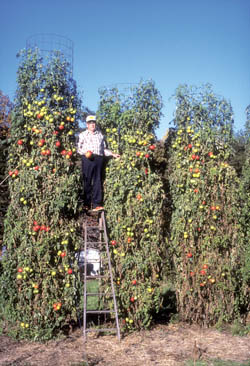In a previous blog post, we discussed how to know when you have a pest problem, and how to choose the least harmful method of dealing with it. But what about before you have a problem? Is there a way to keep the pests out, or to stop them before they take over? In this post, we’ll talk about ways to keep your garden healthy, and discourage pests before they become pesky.
First, you need to start with a healthy environment by getting rid of last year’s problems. If there were fungal issues or scale insects, be sure your plants have plenty of airflow – this could mean pruning trees and shrubs to open them up. Clean up any diseased debris. Wipe down used trellises and pots with a bleach solution. If you are planting annual flowers or vegetables, consider rotating your crops – that is, don’t plant the same thing in the same place year after year. If you always put your tomatoes in the same spot, any lurking disease problems can strike the new plants, and the hornworm caterpillars will know just where to find your prized beefsteaks. Mix it up, to keep pests and diseases from building up.
If your planting beds are covered with weeds or infested with root knot nematodes, consider solarizing the soil. By laying clear plastic over the moist soil and allowing it to bake through the hot summer months, you can kill weed seeds and harmful microorganisms. The downside is that it will also kill many beneficial soil microorganisms, so only solarize if you’ve had problems.

Next, when planning your garden, think about what each type of plant needs. Is it a vegetable that requires full sun? Colorful foliage plants that do best in part shade? A bog plant that wants a wet spot, or Mediterranean herbs that like drier soil? Charles Wilbur, in his book How to Grow World Record Tomatoes, said he just gave the plant exactly the inputs it wanted – the right amount of sun, water, compost, support, pruning, etc, and the plants responded with hundreds of tomatoes. Simple advice, but often ignored as we try to fit one more plant in a crowded landscape or decide we just have to grow broccoli in the heat of summer. Remember – healthy plants may get pests, but stressed plants will get pests.

Finally, invite beneficial insects to your garden. Their job is to keep the bad insects in check. It’s like free pest control! Beneficials love blossoms, so plant different varieties of flowers. I like to plant cilantro and dill during the fall and let it bloom in the spring – a sure way to attract ladybugs. And Dr. Lance Osborne at the University of Florida’s Mid-Florida Research and Education Center has done research to tell us what kinds of plants can lure the best beneficials:
- Thai peppers host a microscopic mite that eats chilli thrips and whiteflies. ‘Masquerade’ and ‘Red Missile’ are two early-fruiting varieties recommended for Central Florida.
- Papaya trees lure the papaya whitefly, which in turn lures tiny (non-stinging) parasitic wasps that will help keep other garden whiteflies in check. Cut yellowing papaya leaves and lay them in your plant beds to help spread the beneficial insects around.
- Milkweed attracts the bright orange oleander aphid. This aphid doesn’t really harm the milkweed, but it attracts lots of aphid-eating insects that will keep your more tender flowers and vegetables aphid-free. As a bonus, monarch butterfly caterpillars will munch the milkweed right out from under the aphids.
Of course if you want beneficial insects in your garden, that means no spraying chemical pesticides! The chemicals can’t tell the difference between friend and foe.

Finally, if pests do strike your plants, practice good sanitation. Just like in a hospital, wash your hands and disinfect your tools between patients… er, plants. I keep a bottle of rubbing alcohol beside my pruners, so I can wipe the blades after cutting a diseased or insect-infested plant. And never compost diseased plant material – seal it up and dispose of it so it can’t spread insect eggs or fungal spores.
In the garden, an ounce of prevention is worth a pound of pesticides. Happy gardening!
This blog post was written by UF IFAS Extension Orange County Master Gardener Volunteer, Mary Ann Pigora, class of 2017. The UF IFAS Extension Orange County Master Gardener Volunteers play a crucial role in the outreach of UF/IFAS Extension.
 1
1
